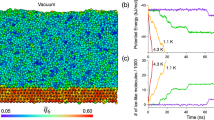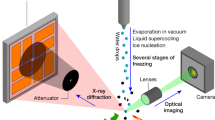Abstract
IT has been found that on very rare occasions long, thin ice needles grow into the air from the solid surface of water frozen in an open container1–4. In the course of supercooling experiments, Dorsey5 observed a similar phenomenon in the laboratory. He assumed that growth occurred when, because of the increase in volume during solidification, water was forced through an opening in the ice covering the surface. Dorsey also suggested that a tube formed, through which water flowed and which “grew” at its tip. Recently, Hayward6 reported a method for growing such spikes and obtained experimental evidence in support of Dorsey's mechanism.
This is a preview of subscription content, access via your institution
Access options
Subscribe to this journal
Receive 51 print issues and online access
$199.00 per year
only $3.90 per issue
Buy this article
- Purchase on SpringerLink
- Instant access to full article PDF
Prices may be subject to local taxes which are calculated during checkout
Similar content being viewed by others
References
Dorsey, H. G., Phys. Rev., 17, 162 (1921).
Bally, O., Helv. Chim. Acta, 18, 475 (1935).
Hallett, J., J. Glaciol., 3, 698 (1960).
Meyer, J., and Pfaff, W., Zeit. Anorg. Allg. Chem., 224, 305 (1935).
Dorsey, N. E., Trans. Amer. Phil. Soc., 38, 248 (1948).
Hayward, A. T. J., Nature, 211, 172 (1966).
Higuchi, K., Acta Met., 6, 636 (1958).
Adamson, A. W., and Dormant, L. M., J. Amer. Chem. Soc., 88, 2055 (1966).
Author information
Authors and Affiliations
Rights and permissions
About this article
Cite this article
KRAUSZ, A., HARRON, B. & LITVAN, G. Tubular Ice Crystals. Nature 215, 271–273 (1967). https://doi.org/10.1038/215271a0
Received:
Revised:
Issue date:
DOI: https://doi.org/10.1038/215271a0
This article is cited by
-
The activation volume associated with the plastic deformation of ice
Applied Scientific Research (1972)



